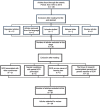Anatomical Changes and Audiological Profile in Branchio-oto-renal Syndrome: A Literature Review
- PMID: 25992067
- PMCID: PMC4296951
- DOI: 10.1055/s-0033-1358659
Anatomical Changes and Audiological Profile in Branchio-oto-renal Syndrome: A Literature Review
Abstract
Introduction Branchio-oto-renal (BOR) syndrome is an autosomal-dominant genetic condition with high penetrance and variable expressivity, with an estimated prevalence of 1 in 40,000. Approximately 40% of the patients with the syndrome have mutations in the gene EYA1, located at chromosomal region 8q13.3, and 5% have mutations in the gene SIX5 in chromosome region 19q13. The phenotype of this syndrome is characterized by preauricular fistulas; structural malformations of the external, middle, and inner ears; branchial fistulas; renal disorders; cleft palate; and variable type and degree of hearing loss. Aim Hearing loss is part of BOR syndrome phenotype. The aim of this study was to present a literature review on the anatomical aspects and audiological profile of BOR syndrome. Data Synthesis Thirty-four studies were selected for analysis. Some aspects when specifying the phenotype of BOR syndrome are controversial, especially those issues related to the audiological profile in which there was variability on auditory standard, hearing loss progression, and type and degree of the hearing loss. Mixed loss was the most common type of hearing loss among the studies; however, there was no consensus among studies regarding the degree of the hearing loss.
Keywords: BOR syndrome; branchio-oto-renal syndrome; hearing; review.
Figures
References
-
- Ramos P Z, de Moraes V CS, Svidnicki M CCM, Soki M N, Castilho A M, Sartorato E L. Etiologic and diagnostic evaluation: algorithm for severe to profound sensorineural hearing loss in Brazil. Int J Audiol. 2013:1–7. - PubMed
-
- Kniffin C L Branchiootorenal syndrome 1; BOR1. OMIM 2012 Available at: http://omim.org/entry/113650. Access date: 10/07/2013.
-
- Heusinger C F. Hals-Kiemen-Fisteln von noch nicht beobachteter form. Virchows. Arch Path Anat. 1864;29:338–380.
-
- Melnick M, Bixler D, Silk K, Yune H, Nance W E. Autosomal dominant branchiootorenal dysplasia. Birth Defects Orig Artic Ser. 1975;11:121–128. - PubMed
-
- Melnick M, Bixler D, Nance W E, Silk K, Yune H. Familial branchio-oto-renal dysplasia: a new addition to the branchial arch syndromes. Clin Genet. 1976;9:25–34. - PubMed
Publication types
LinkOut - more resources
Full Text Sources
Other Literature Sources
Molecular Biology Databases
Research Materials


